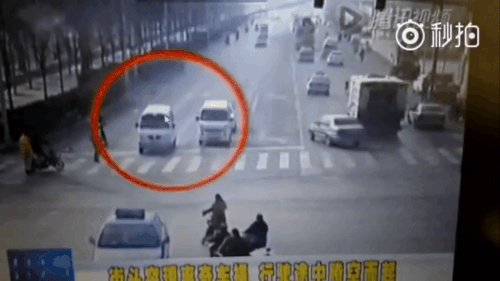
Engineers in China who left a length of steel cable lying across a busy road inadvertently created a novel way of protecting their local zebra crossing. A group of approaching vehicles, that had no intention of stopping for the pedestrians, were picked up and tossed aside like toys.
Why requests for zebra crossings are refused
British drivers are generally very good at stopping at zebra crossings. The problem is that it can be a real struggle to have them installed in the first place. Thousands struggle each day to cross busy streets outside schools, hospitals and homes, but appeals for zebra crossings are routinely turned down on the grounds of cost; according to the Highways Agency it is possible to spend an astonishing £114,000 on a single pedestrian crossing.
The figures came to light when Oliver Letwin MP campaigned for a crossing to be installed outside a school in his West Dorset constituency. When his request was turned down, he asked how much the build costs were so that the money might be raised locally. The £114,000 he was quoted included £11,000 for design work, an additional £16,000 for the beacons, wiring and road signs and an eye-watering £87,000 for labour costs.
We also heard from parents who had been told a zebra crossing could not be installed because it would reduce the number of parking spaces, and, perversely, because no child had yet been seriously injured or killed.
Build your own pop-up zebra crossing
With over 2,000 children killed or seriously injured each year on our roads, it should be possible to have zebra crossing installed outside schools without the need to embarrass the local council in the national media, but in this case that’s what was needed.
When we were approached by a group of parents whose request for a zebra crossing at an accident black spot outside their local infant school had been turned down on grounds of cost, we built one ourselves for as little money as possible.
The result was a pop-up zebra crossing that could be erected on any minor road in less than two minutes. And with no need to consider drainage, the excavation of existing pavement, disposal of material, new kerbs and paving, anti-skid surfacing, road markings and studs, new traffic signs, electrical connections and costly pillars,signal heads and poles, the total cost came to £50 – considerably less than the £114,000 quoted by the Highways Agency.
Faced with coverage of the campaign in the Sunday Times, Daily Mail, Evening Standard and Metro newspapers and on numerous radio stations, the council very quickly installed a real crossing.
The pop-up zebra crossing used recycled linoleum, drain pipes and two orange balloons to create an effect that is almost indistinguishable from the real thing. For more information visit the ETA trust.
Environmentally friendly breakdown cover
Not all breakdown companies are the same. Established over 25 years ago, and with over 5,000 recovery trucks on call 24/7, we have a proven track record of providing efficient, reliable breakdown cover. We have been voted Britain’s most ethical insurance company by the Good Shopping Guide.
We handpick only the best local mechanics and garages around Britain to send out if you break down. We believe this way of working is efficient, environmentally friendly and helps supports local communities and economies, too.
On top of this, we offset the carbon emissions of the recovery trucks that go out to assist you, reducing the impact your breakdown has on our environment. Every breakdown policy you buy helps fund the work of our charity, the ETA Trust, which campaigns for a safer, cleaner transport future.
Maurice Hopper
To have quick and plentiful pedestrian crossings, why don’t we go for the Swiss model. Yellow crossing panels in the road instead of our white markings, two triangular crossing signs ( so the crossing can be seen in the snow!) and motorists who stop. They are often less than 100 metres apart, allowing pedestrians much greater freedom to cross… But don’t expect a motorist to slow down if you are crossing the road between these more numerous pesdestrian crossing places.